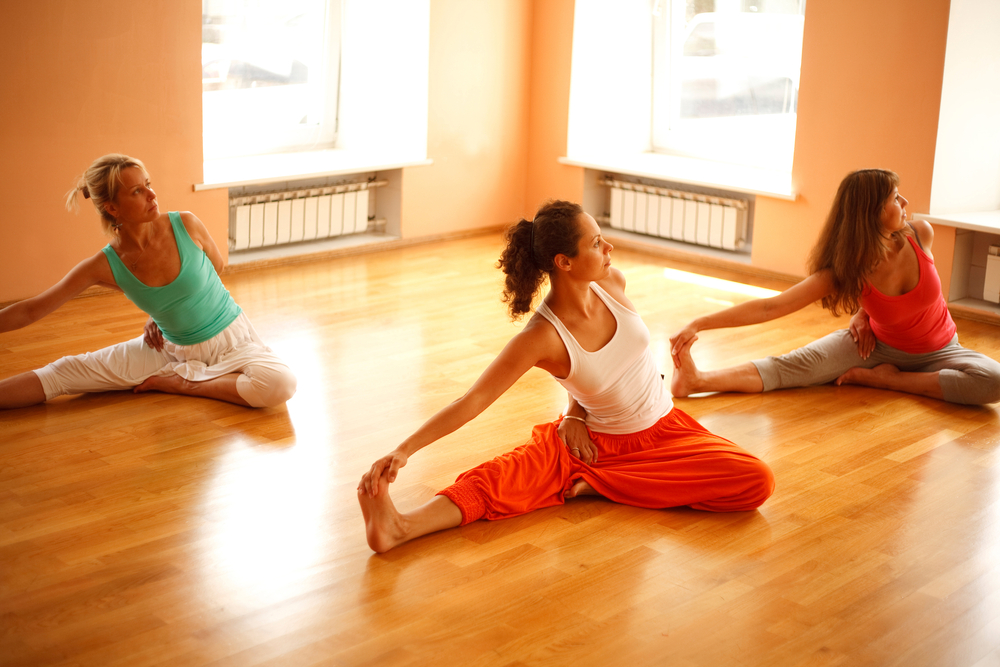
What is Hatha Yoga?
There are dozens and dozens of different types of yoga. How are you supposed to know what is best for you? And what's the point of yoga anyway? In this second part of Lucy Greeves' guide to the ancient practice she explains the practice and aims of hatha yoga
The low-down
Strictly speaking, all the yoga classes you're likely to encounter are 'hatha yoga' classes; the Sanskrit term is the original name for the physical discipline we call yoga. But in practice, the classes that tend to be advertised as 'hatha yoga' are the vanilla ice cream of the UK yoga scene, and a great place for beginners to start.
What happens in class?
Grab a mat, leave your shoes outside and listen carefully! Yoga asana (postures) are precise and detailed, and their full expression can come down to such seemingly trivial things as the placement of your fingers and the direction of your gaze. The full subtlety won't be apparent straight away, but that's ok. The aim is to approximate the posture more and more closely until you get there – and 'there' isn't necessarily a perfect-looking shape, more a specific energetic alignment. The teacher will give verbal instructions and may also demonstrate the poses.
In a hatha yoga class, expect a steady pace, with a range of classical yoga asana (postures), a smattering of Sanskrit terms, and some instruction in how to breathe in the pose. Classes are generally 60 or 90 minutes long. You'll start with warm-up exercises, progress to holding stronger poses (hatha yoga offers a mixture of standing poses, forward bends, back bends, twists, balances and inversions), then most classes will end with a period of relaxation (lying or sitting) and some may include pranayama (formal breathing practice) and meditation.
Who goes?
All sorts. Hatha yoga accommodates all shapes and sizes and levels of physical fitness. If you're a complete beginner, ask beforehand if the class is suitable.
Who should avoid it?
Go carefully - and always tell the teacher if you are recovering from surgery, spinal injuries like whiplash or disc problems, or less than a year post-natal. Yoga can be great for pregnant women, but certain postures and breathing practices are not suitable during pregnancy so a specialist ante-natal yoga class is generally recommended unless you are already quite experienced. If you have asthma, high or low blood pressure, epilepsy or diabetes, it's a good idea to let the teacher know at the start of the class.
What will it do for me?
Hatha yoga builds strength and flexibility throughout the body. That means long, lean muscles, a strong core and a well-balanced physique. It also improves posture and balance. It can also improve lung capacity and breath control, but it's not a substitute for a cardiovascular work-out: you won't sweat much and you won't get out of breath (unless you're quite unfit to begin with!).
It works slowly and steadily, and most bodies respond best to regular practice; students attending at least 2 classes a week will start to see physical benefits within a couple of months. It's a great thing to combine with other forms of exercise that use the body's natural range of motion - running, cycling, swimming and so on. But perhaps the most important benefits are about mind-body. Yoga practice has been proven to diminish the body's 'fight or flight' stress response and put the mind and body into 'rest and digest' mode. It does this more efficiently than most other physical exercise classes because the breathing techniques and positioning of the body during asana are specifically designed to still the mind in preparation for meditation, and have been refined and tested over many centuries. Even if you aren't interested in meditating, techniques learnt in class can improve concentration span, reduce anxiety, and generally encourage a less frantic approach to life.
Finding a good teacher
There is no single supervising body for hatha yoga in the UK, and it is possible to set oneself up as a yoga teacher with little or no training. So if you're a beginner, do a bit of research and make sure your teacher is fully insured, has at least 500 hours of training, and preferably a few years' teaching experience, too. It's safest to look for teachers with a qualification that's recognised by one of the main organisations of yoga professionals: the British Wheel of Yoga (BWY) and Yoga Alliance (YA). All BWY diploma courses are at least 500 hours; YA certifies teachers at 200 and 500-hour levels. A third body, the Independent Yoga Network, is home to many of the (often very experienced) teachers who have fallen out with either the BWY or YA!
Further reading
Click here to buy Yoga for You (Healthy Living): A Step-by-step Guide to Yoga at Home for Everybody
Click here to buy Yoga: The Spirit and Practice of Moving Into Stillness
Click here to buy Asana, Pranayama, Mudra and Bandha










